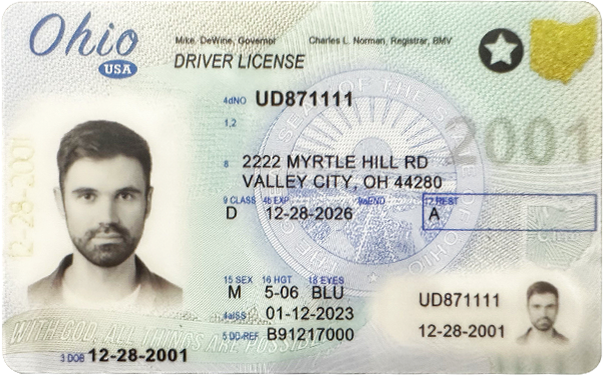Introduction
Travel agencies often encounter situations where they need to verify the authenticity of a customer’s driver’s license, especially when services such as car – rental or chauffeur – related arrangements are involved. A fake driver’s license can pose significant risks, including legal liabilities and potential safety issues. This article will explore the various ways travel agencies check for fake driver’s licenses.
Visual Inspection
The first line of defense for travel agencies is a visual inspection of the driver’s license. There are several key elements to look for:
- Security Features: Most genuine driver’s licenses have advanced security features. These can include holograms, which are three – dimensional images that are difficult to replicate. For example, in many states, there may be a holographic image of the state seal or the license – holder’s photo on the license. Travel agents should be trained to identify the proper placement and quality of these holograms. If the hologram looks blurry, out of place, or has a poor quality, it could be a sign of a fake license.
- Microprinting: Another security feature is microprinting. This is extremely small text that is often found on the license. Microprinting is difficult to reproduce accurately. Travel agencies can use magnifying glasses to check for the presence of microprinting and verify its clarity and content. If the microprinting is missing, blurry, or contains incorrect information, it may indicate a fake license.
- Color and Printing Quality: The color and printing quality of a driver’s license can also provide clues. Genuine licenses are printed with high – quality inks and have a consistent color scheme. Faded colors, uneven printing, or smudged text may be signs of a fake. For instance, the text on a real license should be sharp and well – defined, while on a fake one, it may appear pixelated or have irregular edges.
Verification of Information
Travel agencies also cross – check the information on the driver’s license with other reliable sources:
- Personal Information: They verify the personal information such as the name, date of birth, and address on the license. This can be cross – referenced with the customer’s other identification documents, such as a passport or a government – issued ID card. If there are discrepancies in the spelling of the name, the date of birth, or the address details, it could be a red flag. For example, if the name on the driver’s license is spelled differently from the name on the passport, further investigation is required.
- License Number: The license number is a unique identifier. Travel agencies can contact the relevant department of motor vehicles (DMV) in the state or country where the license was issued. They can provide the license number and request verification of the license’s authenticity. Some states also have online portals where basic license information can be quickly checked. If the license number does not match the records in the DMV database, or if there are no records associated with the number, it is likely that the license is fake.
Signature Comparison
When a customer presents a driver’s license, travel agencies may also compare the signature on the license with other signatures provided by the customer. For example, if the customer has filled out a registration form or signed a contract, the signature on these documents can be compared with the one on the driver’s license. Discrepancies in the writing style, such as differences in the slant, the way letters are formed, or the pressure applied during writing, can indicate a problem. However, this method is not always conclusive, as some people may have variations in their signatures over time.

Technology – Based Checks
In addition to traditional methods, travel agencies are also increasingly relying on technology to detect fake driver’s licenses:
- ID Scanners: Many travel agencies use ID scanners. These scanners can read the magnetic stripe or the RFID (Radio – Frequency Identification) chip on the driver’s license. They can quickly extract information from the license and compare it with pre – set parameters. If there are any irregularities in the data format or if the information does not match the expected standards, it can be flagged as a potential fake. For example, if the scanner is unable to read the magnetic stripe properly or if the data retrieved from the RFID chip is incomplete or inconsistent, it may indicate a counterfeit license.
- Database Cross – Referencing: There are national and international databases that contain information about fake or revoked driver’s licenses. Travel agencies can subscribe to these services and cross – reference the details of the driver’s license they have received. If the license number or the name of the license – holder appears in the database of fake licenses, it is an immediate red flag. These databases are constantly updated with the latest information about counterfeit licenses, making them a valuable resource for travel agencies.
Training and Staff Awareness
Ensuring that travel agency staff are well – trained in license verification is crucial. Staff should be educated about the latest security features of driver’s licenses, as well as the common methods used to create fake licenses. Regular training sessions can be organized to keep them updated on the evolving techniques of fraud detection. For example, they can be trained on how to spot new types of counterfeit holograms or how to use the latest ID – scanning technology effectively. Additionally, staff should be aware of the legal implications of accepting a fake driver’s license and the importance of thorough verification.
Common Problems and Solutions
Problem 1: Incomplete or Incorrect Information on the License
Description: The driver’s license may have missing fields, incorrect spellings, or inconsistent information. For example, the address may be incomplete, or the date of birth may not match the format required by the issuing authority.
Solution: Request the customer to provide additional documentation to verify the correct information. This could be a utility bill with the correct address or a birth certificate for date – of – birth verification. If the customer is unable to provide satisfactory documentation, further investigation or refusal of services may be necessary.

Problem 2: Difficulty in Reading the Magnetic Stripe or RFID Chip
Description: The ID scanner may have trouble reading the magnetic stripe or the RFID chip on the driver’s license. This could be due to damage to the license, a malfunctioning scanner, or a fake license with a non – standard or non – existent magnetic stripe or chip.
Solution: First, try using a different ID scanner to rule out scanner malfunction. If the problem persists, visually inspect the license for signs of damage to the magnetic stripe or chip area. If the license appears to be damaged, request the customer to provide an alternative form of identification. If the license seems undamaged and still cannot be read, it may be a fake, and further verification steps should be taken, such as contacting the DMV.
Problem 3: Discrepancies in the Signature
Description: The signature on the driver’s license does not match the signature on other documents provided by the customer. This could be due to a genuine variation in signature over time or a fake license with a forged signature.
Solution: Ask the customer to explain the differences in the signatures. If the explanation is reasonable, such as a change in signature style due to a long – term injury, request additional identification with the new signature style. If the explanation is not satisfactory, contact the DMV to see if they have a record of the customer’s signature on file for comparison. If the DMV does not have a record or if the signatures still do not match, consider the license as potentially fake.
Problem 4: Inability to Contact the DMV
Description: There may be difficulties in contacting the relevant DMV, such as long waiting times on the phone, unresponsive online portals, or incorrect contact information. This can hinder the verification process of the driver’s license number.
Solution: Try alternative contact methods for the DMV, such as using different phone numbers or email addresses if available. If the online portal is unresponsive, check for system announcements or try again at a different time. If all else fails, request the customer to provide additional documentation to support the authenticity of the license, such as a recent vehicle registration document or a letter from the DMV.
Problem 5: Lack of Awareness Among Staff
Description: Staff may not be aware of the latest security features of driver’s licenses or the common signs of fake licenses. This can lead to overlooking potential fake licenses during the verification process.
Solution: Conduct regular training sessions for staff on license verification. These sessions should cover the latest security features, new types of fake licenses in circulation, and the proper use of verification tools such as ID scanners. Provide staff with sample fake licenses (for training purposes only) so that they can practice identifying the differences between genuine and fake licenses. Additionally, encourage staff to report any suspicious licenses they encounter and provide them with feedback on their verification efforts.
Fake ID Pricing
unit price: $109
| Order Quantity | Price Per Card |
|---|---|
| 2-3 | $89 |
| 4-9 | $69 |
| 10+ | $66 |



